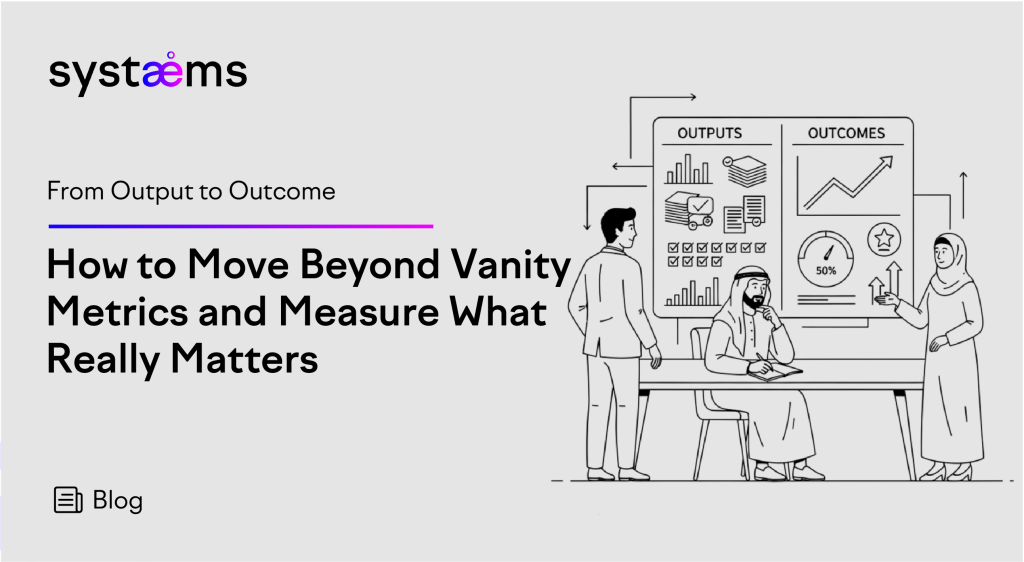From Output to Outcome: How to Move Beyond Vanity Metrics and Measure What Really Matters
Shift focus from vanity metrics to outcome-driven measurement for impactful organizational performance.

Organizations often celebrate numbers such as hours logged, reports delivered, or projects completed without asking: Do these metrics reflect true progress?
These are vanity metrics; statistics that may look impressive on a report but rarely prove whether strategic objectives are being achieved. The danger is that leaders may feel a sense of progress while the organization fails to deliver real impact.
The shift from output-driven measurement to outcome-based performance metrics is no longer optional. It is essential for organizations that want to ensure their resources are creating value and that their efforts align with long-term goals.
At Systaems, this principle drives our consulting and technology solutions. We help organizations connect data, KPIs, and strategy so that every measure reflects what truly matters.
Understanding the difference between outputs and outcomes is the foundation for meaningful measurement.
Consider a company that completes 50 projects in a year. On paper, this looks like success. But if only 20 of those projects generate measurable results, the other 30 are vanity. Outputs are useful but insufficient. Outcomes tell the real story.
The distinction is not just academic. It directly affects sustainability, competitiveness, and stakeholder trust.
Boards, regulators, and investors now expect transparency on impact, not just activity. Delivering dozens of reports means little if they do not lead to better governance or compliance.
Outcome-based metrics ensure that measurement reflects vision and mission. If an organization claims sustainability is a priority, its metrics must show actual carbon reduction, not just the number of sustainability workshops held.
Shifting to outcomes prevents wasted effort. Instead of measuring how much is done, organizations focus on what delivers the most value.
When outcomes drive performance, employees understand that impact matters more than busyness. This fosters accountability, innovation, and alignment with purpose.
Anchor all KPIs to business goals. If growth is the objective, measure new market penetration or customer lifetime value, not the number of meetings conducted.
Financial results are important, but outcomes also include customer trust, employee engagement, and social impact. Together, they create a holistic view.
Reliable outcomes require clean, structured, and integrated data. At Systaems Data Services, we design governance frameworks and visualization tools to ensure accurate, actionable insights.
Markets shift, priorities evolve, and strategies change. Outcomes must adapt. A metric that mattered yesterday may not define success tomorrow.
At Pengurusan Aset Air Berhad (PAAB), executives faced a familiar challenge: data overload. Reports highlighted asset usage, maintenance schedules, and technical activities. But leaders struggled to see whether these outputs translated into efficiency gains or improved public service delivery.
Working with Systaems, PAAB implemented performance dashboards that shifted focus from activities to outcomes. Instead of simply reporting on assets in use, executives tracked metrics like compliance rates, service reliability, and operational resilience.
This transformation allowed leaders to prioritize investments and decisions that enhanced water delivery efficiency, improved regulatory compliance, and increased public trust.
Technology enables organizations to move beyond vanity metrics by making outcomes measurable and transparent.
At Systaems, we combine governance with technology so that measurement is not just a reporting exercise but a driver of strategy and transformation.
While outcomes should be prioritized, outputs still have value. They provide indicators of effort and process, which can inform improvement. The key is balance.
For example:
Together, they show not only that activity occurred but that it delivered value.
Organizations that embrace outcome-based metrics prepare themselves for the future in several ways:
Outcome-based performance management is not just a reporting upgrade. It is a strategic transformation that strengthens resilience in a competitive environment.
Moving from outputs to outcomes represents more than a measurement change. It is a cultural shift toward accountability, impact, and long-term value.
As the PAAB case shows, when organizations move beyond vanity metrics, they uncover insights that lead to stronger performance, regulatory compliance, and public trust.
At Systaems, we design outcome-based performance systems that align data, strategy, and governance. If your organization is ready to ensure that every number tells a meaningful story, reach out to us today.
Shift focus from vanity metrics to outcome-driven measurement for impactful organizational performance.
Empower teams with KPIs and data insights to foster accountability, agility, and sustainable growth.
Align strategy with performance management to drive measurable, sustainable organizational growth.
